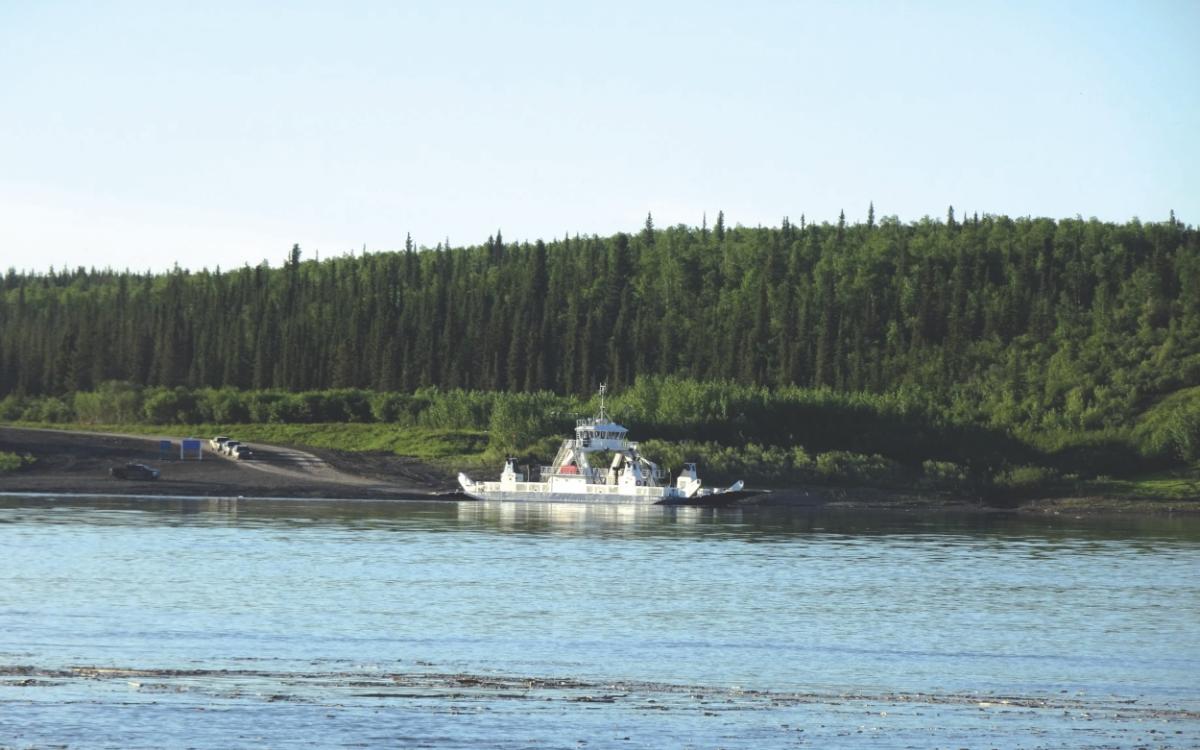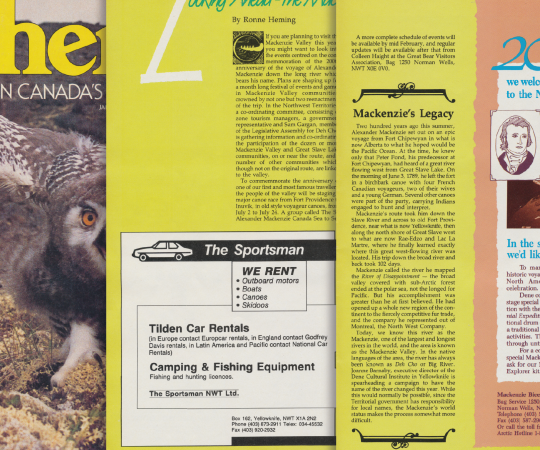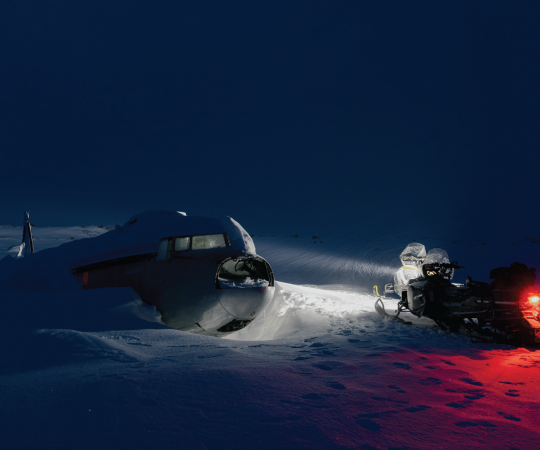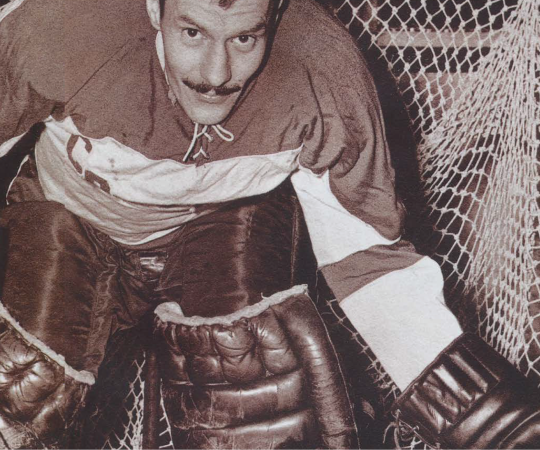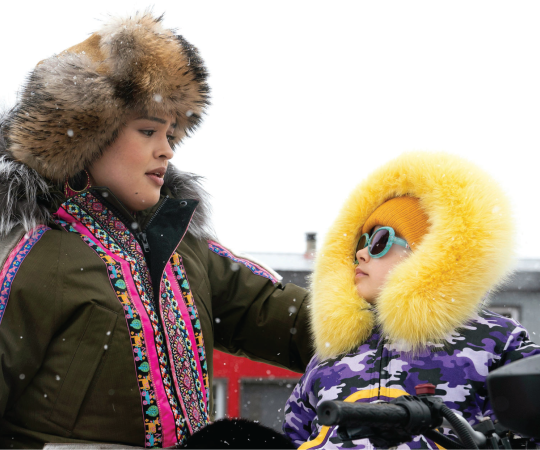IT’S NOT YET 8:30 A.M., and Darcy Firth is settled in the wheelhouse of the MV Louis Cardinal, surveying the fast-flowing Mackenzie River before him. He stands at the helm of a technological smorgasbord—depth-sounding radars, jog sticks for steering, radios crackling with crew chatter and passing barges signalling their presence. It’s a spread of equipment the 45-year-old is intimately familiar with.
Firth has captained this ferry for six years now, running a triangular route at the confluence of the Mackenzie and the Arctic Red River. Every day, he dodges fishing boats and shallow banks in the riverbed, cutting through waves for eight minutes one way to pick up passengers and vehicles lined up on the shore. Then he heads back the other way, connecting the small NWT community of Tsiigehtchic, as well as Mackenzie Delta communities like Inuvik, to the rest of the territory by road. Firth and his crew aren’t bound by a schedule. Whenever there are people waiting, the Louis Cardinal will go.
So is a day in the life of a Northern ferry captain. Cars load on and the gate goes up. The boat slogs through the swift current and lands on the far bank. The gate goes down and cars go on their way. Six months a year, seven days a week, eight hours a day, Firth is there in the wheelhouse, piloting his vessel back and forth across the Mackenzie River.
He doesn’t mind the monotony. “It’s a pretty good gig all around,” he says. “All summer, we have nice, sunny days. We get fresh air cruising around on the river, and no bugs get at you.
“It’s beautiful.”
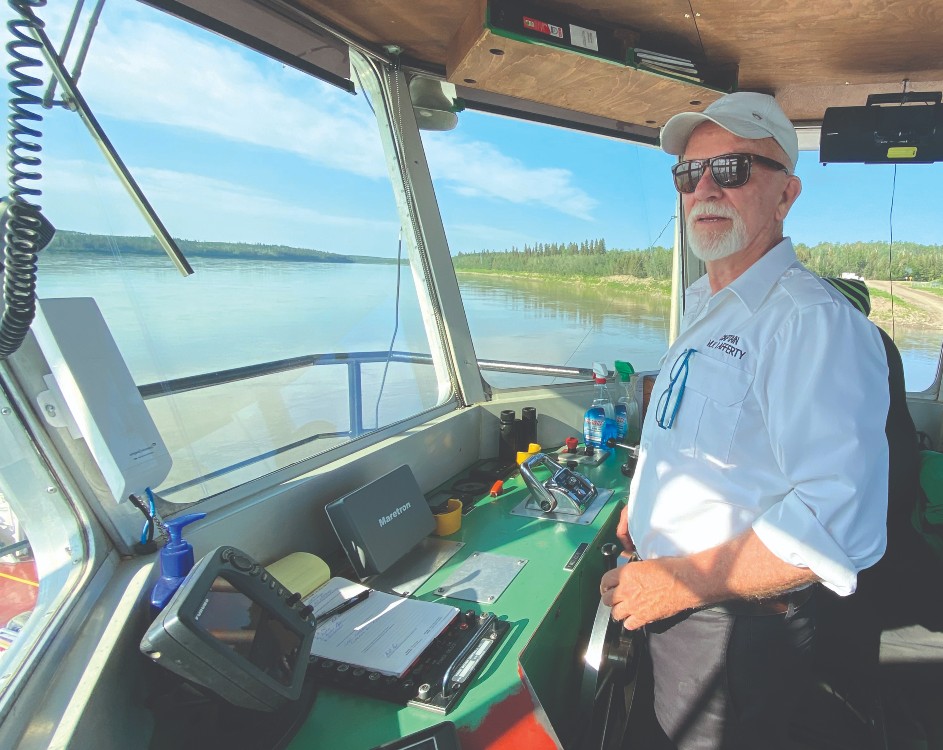
FERRIES ARE LINCHPINS for transportation in the North. They’re pushed in when the rivers melt, running the span of spring, summer and fall, then hastily pulled out when temperatures drop and ice crossings take their place.
The system was developed in tandem with highways. As roads reached further into the North in the 20th century, snaking their way through boreal forests and over the tundra, ferries quickly became the cheapest and most practical option, where bridges weren’t possible, to barge vehicles across waterways and provide continuity to the Arctic’s bud- ding mobility.
Today, there are four seasonal ferries operating in the NWT and two in the Yukon. Each is responsible for linking a different roadway. Each is available free of charge. Each is operated by its own cast of characters.
Many of the workers are locals, acquainted with the seamless way that ferries have become a part of everyday life. Firth himself grew up between Fort McPherson and Inuvik, and spent many afternoons commuting across the Mackenzie, the Arctic Red and the Peel rivers to visit family or grab groceries. He had already been working as a deckhand for nine years when he became the boat’s first Gwich’in captain in 2016.
Over in the Yukon, Tr'ondëk Hwëch'in resident David Hutton captains the George Black Ferry in Dawson City. He transports locals and tourists across the Yukon River, which his people have lived on for thousands of years.
Other captains are transplants from elsewhere in the country, experienced mariners looking to try something new. Jock Palmer had retired from BC’s ferry service before coming to the NWT in 2010 to captain the MV Louis Cardinal, on a cross-shift from Firth. Palmer hasn’t captained a ship since retiring for real in 2013, but he often thinks back to his time on the Mackenzie River. “I’ve never worked anywhere where you couldn’t see two inches into the water,” he says. “It was always muddy. I called it ‘running in chocolate pudding.’”
Meanwhile, 72-year-old Graham Cox has captained the MV Lafferty across the Liard River for the past16 years. Having spent most of his career out on the water, he agreed to take work in the NWT merely as “a fun thing to do.”
“My great uncle was a schooner master on the ocean between Glasgow, Liverpool, and Halifax,” he says. “I don’t know if that puts it in your blood or what, but I grew up around sailors.” Cox keeps coming back to the North year after year.
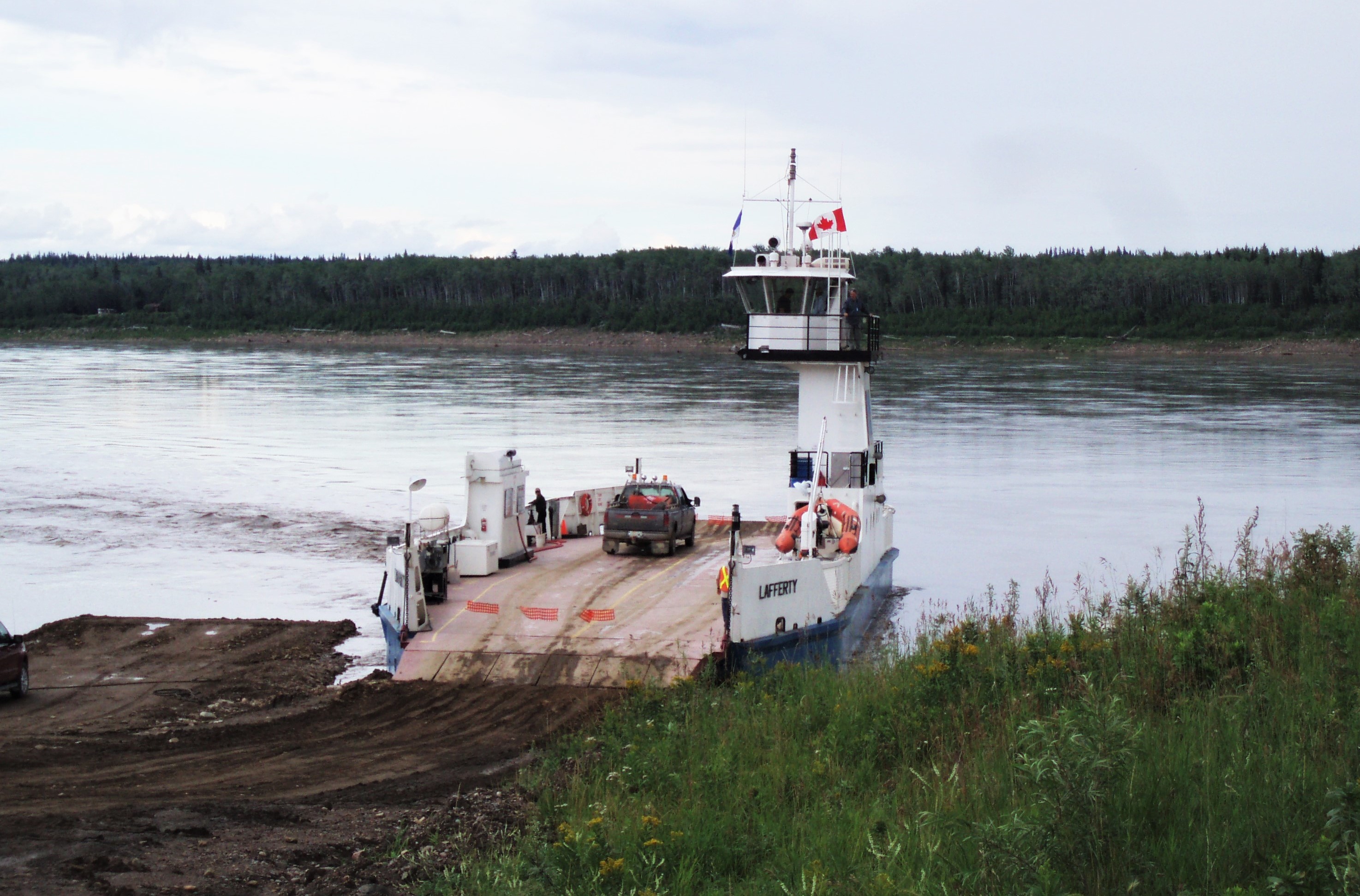
THERE’S A CERTAIN ROMANTICISM afforded to ferries in the North. Each captain has numerous stories of the giddy travellers they’ve met, with some coming from as far afield as Russia, Australia, and Switzerland. “I’ve met a lot of people from all over the world,” Firth says. “I actually keep in touch with them, too. I’ve made friends with people who come visiting.”
One such friend is Félix-Antoine Tremblay, a cyclist from Montréal.
Four years ago, Tremblay was nearing the end of a 14,000-kilometre cycling trip, veering north to explore the newly-opened highway to Tuktoyaktuk. When he boarded the Louis Cardinal, he met Firth, who could see that Tremblay was tired and muddy from cycling for days on end. Firth invited the traveller to spend a night at the ferry camp that housed workers from out of town. There, they shared a home-cooked meal, and Tremblay was able to shower and do laundry.
The hospitality of the crew helped Tremblay finish the final leg of his journey to Tuk. All these years later, he still remembers their kindness and the wonder of the boat. “It’s funny. I don’t allow myself to cheat, in my own words, when I’m on a cycling trip,” he says. “But taking a ferry is the only way that I accept motorized transportation. Obviously, I cannot ride my bike on the water and it provides you with views you do not get otherwise.”
Although a ferry ride provides a scenic rest for passengers, travelling across these great Northern rivers is no simple feat. Water levels fluctuate greatly and rapidly, currents can be unforgiving, and the wind is a perpetual element of surprise. Those in the wheelhouse are constantly taking the pulse of the river to understand how it’s moving, then maneuvering it accordingly.
“It takes a lot of time and patience to learn to drive it properly,” Yukon River captain Hutton warns. “If you make a wrong turn and the current catches you, it will spin you around.”
The Yukoner speaks from personal experience. He sheepishly recalls a mishap during his captain’s training; overzealous with the rudder, he was snagged by the river and the George Black spun 360 degrees. “I felt really embarrassed,” Hutton recalls, “but the captain who was training me at the time just laughed. He said it happens to everyone.”
Operating during break-up and freeze-up is yet another annual nuisance for crews. Chunks of ice become almost bullet-like in their escape upstream. The later into the season, the more difficult it is to slip through channels.
Just ask Cox. He was aboard the MV Lafferty when it was stuck roughly 200 metres offshore in the frozen Liard for nearly four days in November 2020. The vessel had to be slowly dragged through the ice with winch lines and a host of other tools. “We were fine,” Cox says, assuredly. “Actually, we were more than fine. We were on overtime.”
Palmer was acquainted with the perils of the North’s shoulder seasons well. “A big chunk of ice could come down the river and hit you while you were unloading or loading,” he says. “If you saw that ice coming, you would get on the radio to the crew to stop loading, or get the truck off quick, because you knew what was going to happen. It certainly kept you on your toes.”
A changing climate makes the unpredictably more acute every year, as water levels climb and river habits shift. In the face of these growing hazards, ferries become even more important in maintaining the critical lifeline for communities.
Cox thinks back to last spring, when the NWT’s Dehcho region was hard-hit by mass flooding. Hundreds of families were displaced and forced to either set up camp on the outskirts of town or to evacuate by plane. The captain was in the community at the time, helping scrape and paint the Lafferty to get it ready for the upcoming season.
By the time the ferry was up and running in late March, residents of Fort Simpson—largely underwater after the Mackenzie spilled its banks—were clamouring to get on. “They were stuck there: no shopping or groceries,” Cox says. “Everybody wanted to get out of town.
“And now that everyone is back to normalish, they’re just wondering about next year,” he says. “Is this going to be a trend, or just an anomaly?”

WITH THE UNIQUE challenges of their jobs comes a lifetime of stories.
For Palmer, picking a favourite memory from his time up North is difficult. Maybe it was when a beaver swam from the river and boarded the ferry as if to get to its next location. Perhaps it was the time a local Elder brought him a personal bucket of soup and bannock after learning he didn’t get any the last time she came around with food. Or it could simply be the time he spent unwinding with his fellow crew-mates at the ferry camp set up to accommodate out-of-town workers, eating caribou and moose smokies and laughing over the day’s events.
Each captain speaks about their colleagues with similar affection. Over the course of a season, crews become incredibly tight-knit. It’s a bond forged through long hours, creaking metal, and rollicking waves. “You just become a family,” Palmer says.
From his seat in the wheelhouse, Firth savours both the good and the bad of life on a ferry.
He relishes the dicey weather that gives him a chance to put his skills to the test, but he lives for the moments when the waters are calm and he can enjoy the scenery and people around him. He has no doubt captaining the MV Louis Cardinal is his calling. The humble vessel is a backbone of transportation: a service loved by visitors, but needed by the North.
Besides, Firth never gets tired of being out on the mighty Mackenzie.
“I’ve got the best office view in the whole North of 60.”

